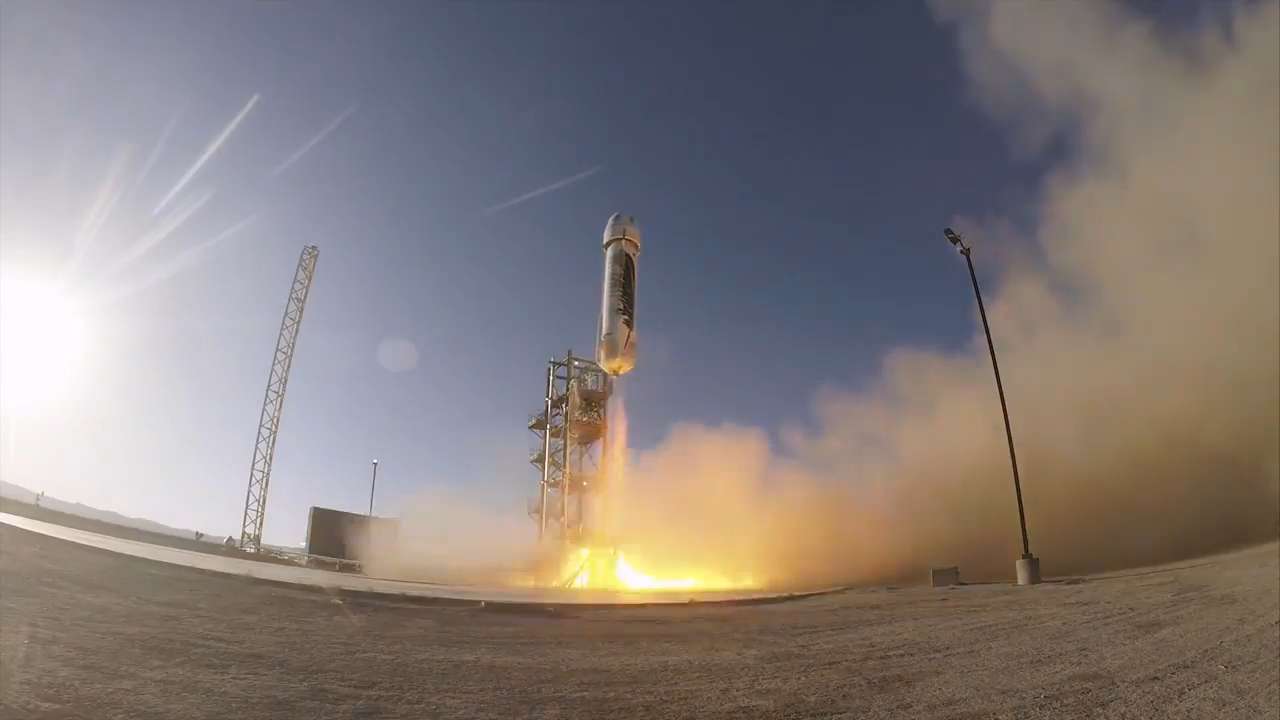
Blue Origin, the private space company founded by billionaire Jeff Bezos, launched its passenger spaceship New Shepard on a test flight Sunday (April 29), carrying a dummy astronaut and experiments on their highest spaceflight yet.
The New Shepard 2.0 rocket and capsule, which have both flown in space before, lifted off from Blue Origin’s West Texas launch site at 1:06 p.m. EDT (1706 GMT). Despite several hours of delays (thunderstorms thwarted a 9:45 a.m. EDT launch target) and countdown holds for last-minute checks, the flight appeared to go flawlessly.
“Another spectacular test mission,” Ariane Cornell of Blue Origin said during a launch webcast. “Everything looks nominal from here.”
Blue Origin launched New Shepard to a target altitude of 347,485 feet (105,913 meters), Cornell said after the launch. That’s almost 66 miles (106 km), slightly higher than the company’s typical target of 62 miles (100 km) — the altitude widely accepted as the boundary line for space, Cornell said.
“Today, we’re going to push the system a little bit harder,” Cornell said during the launch webcast.
Sunday’s launch marked the second flight of Blue Origin’s New Shepard 2.0 vehicle (after a successful December 2017 test launch) and eighth test flight overall for the company’s New Shepard program. An earlier version of New Shepard launched a series of missions in 2015 and 2016 before it was retired.
From liftoff to landing, Sunday’s test flight lasted about 10 minutes, 19 seconds. After launching the New Shepard capsule, the booster separated and returned to its launch site, ,where it made smooth vertical landing. The capsule fell back to Earth a few minutes later, descending on parachutes and cushioning its own landing with retrorockets.
Blue Origin’s New Shepard 2.0 space capsule is designed to fly 6 passengers on suborbital space tourism flights — trips that reach space but don’t orbit the Earth — and can also carry commercial payloads and experiments. It has 6 large windows to give paying passengers wide views of Earth from space. However, Blue Origin has not yet announced how much a ticket to fly on New Shepard will cost.
For Sunday’s mission, Blue Origin’s dummy astronaut — affectionately nicknamed “Mannequin Skywalker” — rode in a passenger seat alongside a series of customer science and technology experiments. Those payloads include an experiment for NASA’s Johnson Space Center; several others from European universities funded by the German Aerospace Center (DLR); and a “Schmitt Space Communicator” for the company Solstar, which named the experiment after Apollo 17 astronaut Harrison Schmitt (a Solstar advisor).
More New Shepard test flights are expected in the coming months. If all goes well, Blue Origin could potentially begin launching people into on New Shepard this year, company representatives have said.
Meanwhile, Blue Origin is busy developing a larger rocket called New Glenn that will launch missions all the way to orbit from Florida’s Cape Canaveral Air Force Station in the 2020s. Like New Shepard, the heavy-lift New Glenn rocket will be reusable and fly people into space.
During Sunday’s launch webcast, Cornell said Blue Origin’s first New Shepard customers will get first dibs on those orbital New Glenn spaceflights, but will have to wait until the 2020s for a chance to fly.

